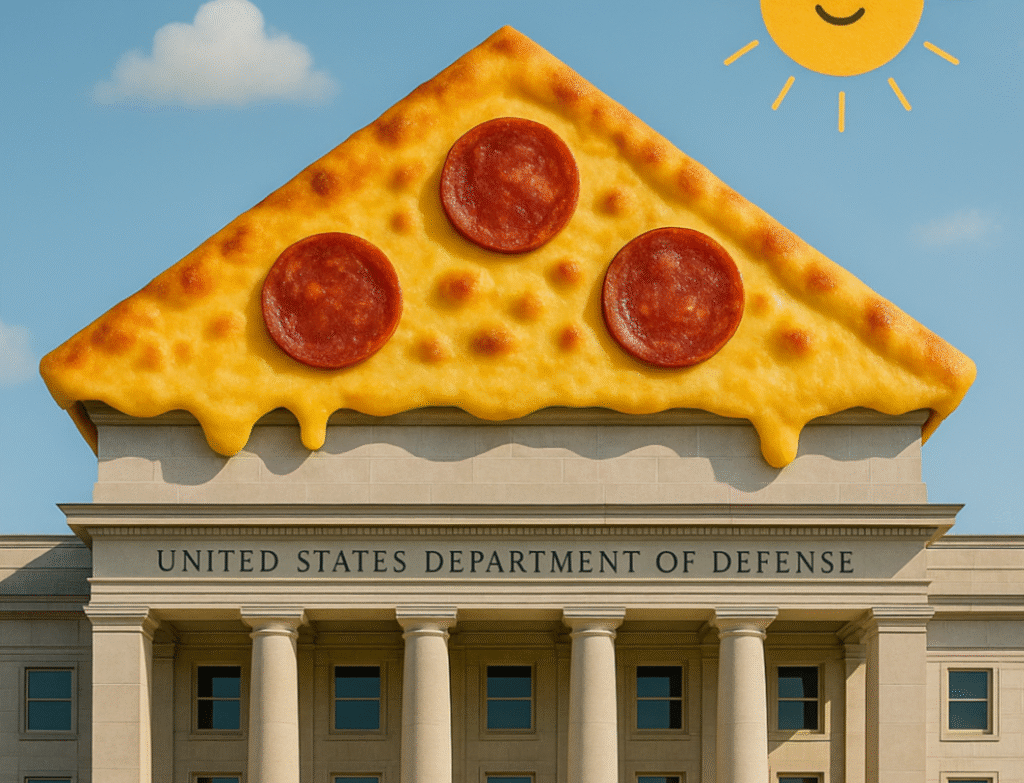
I. Introduction
- The Pentagon Pizza Index hypothesizes that major military decisions and classified war-room sessions trigger late-night food demands, most commonly fulfilled by nearby pizza establishments.
- The theory suggests that analyzing sudden surges in pizza orders—particularly within a 1–2 km radius of the Pentagon—can serve as an indirect but useful indicator of upcoming military action.
II. Mechanism Behind the Theory
- Behavioral Pattern: Military personnel engaged in long, unscheduled operations require fast, bulk food.
- Proximity Factor: The Pentagon’s location in Arlington, Virginia is surrounded by multiple popular pizza chains.
- Data Sources: Publicly available location analytics, Google Maps’ “popular times,” delivery service app data, and social media reports.
- Tracking Accounts: Twitter/X account “Pentagon Pizza Report” and Reddit communities track these fluctuations using OSINT.
III. Documented Historical Incidents (Timeline)
| Date | Event | Observed Pizza Spike | Correlation/Outcome |
|---|---|---|---|
| Aug 1, 1990 | Pre-Gulf War | Surge in pizza orders around Pentagon | Saddam Hussein invaded Kuwait the next day |
| Jan 1991 | Desert Storm buildup | +100 pizzas ordered over several days | U.S.-led coalition attacked Iraq |
| Dec 1998 | Operation Desert Fox | Pizza spike reported on 3 Pentagon-area chains | Bombing campaign on Iraq launched by Clinton administration |
| Oct 1998 | Clinton Impeachment Hearings | Unusual volume of orders at night | White House legal defense meetings ongoing |
| May 2011 | Osama Bin Laden Raid | Delivery spike detected at Joint Base Andrews | Successful Navy SEAL operation executed in Pakistan |
| Jan 2020 | Qasem Soleimani Strike | Spikes at multiple Northern Virginia pizza outlets | U.S. drone strike conducted in Baghdad |
| June 12, 2025 | Israel-Iran escalation | 4 outlets show ~3.8x increase in late-night orders | Israeli airstrikes hit Tehran hours later |
IV. Criticism & Limitations
- Official Dismissals: The Pentagon officially denies reliance on external food during sensitive meetings.
- False Positives: Not all spikes correlate with military actions.
- Data Ambiguity: Not all location services provide real-time, accurate, or high-resolution data.
- Confirmation Bias: Analysts may retroactively associate data with events.
V. Cultural & Intelligence Legacy
- Cold War Soviet surveillance reportedly included tracking food orders in Washington, D.C.
- The practice was nicknamed “Pizzint” (Pizza Intelligence).
- Journalists and analysts have humorously referenced this index during major global events.
VI. Conclusion
While not a definitive or scientifically verified metric, the Pentagon Pizza Index reflects the growing power of behavioral OSINT (Open Source Intelligence). In an age of digital footprints, even a humble pizza order can offer clues to geopolitical movements—reminding us that no detail is too small to be irrelevant in the intelligence ecosystem.
Appendix: Key Monitoring Platforms
- Twitter: @PentagonPizzaReport
- Reddit: r/OSINT and r/Geopolitics
- Google Maps
Recommended Citation: Pentagon Pizza Index: A Behavioral Indicator of Impending Military Action.
Pingback: URI 2.O:Indias Another Surgical strike – this time (in Myanmar) - Anything